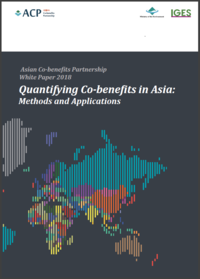
The Paris Agreement and the 2030 Agenda for Sustainable Development have generated a fast-growing interest in strengthening the links between climate change and other development priorities in Asia. Due to this growing interest, policymakers are increasingly looking for tools and methods that can analyse linkages between climate change and development priorities.
This white paper, Asian Co-benefits Partnership White Paper 2018, Quantifying Co-benefits in Asia: Methods and Applications, aims to equip policymakers and practitioners with a broader and deeper understanding of specific tools that can quantify co-benefits. These include the Long-range Energy Alternatives Planning system Integrated Benefits Calculator (LEAP-IBC), a model that can estimate the impacts of different policy scenarios on multiple pollutants, human health, and other endpoints, used in Bangladesh to formulate action plans for shortlived climate pollutants; the Greenhouse gas–Air pollution Interactions and Synergies (GAINs) model, used to estimate changes in emission, ambient air quality, changes in premature death, and climate from heavy-duty diesel regulations implemented in the Tokyo Metropolitan Region in the early 2000s; the Transport Emissions Evaluation Model for Projects (TEEMP), used to assess the Harbin Green Bus Corridor and the transport elements of the Philippines Intended Nationally Determined Contribution (INDC), and various tools used to assess the emissions of multiple pollutants in Nepal’s brick sector.
